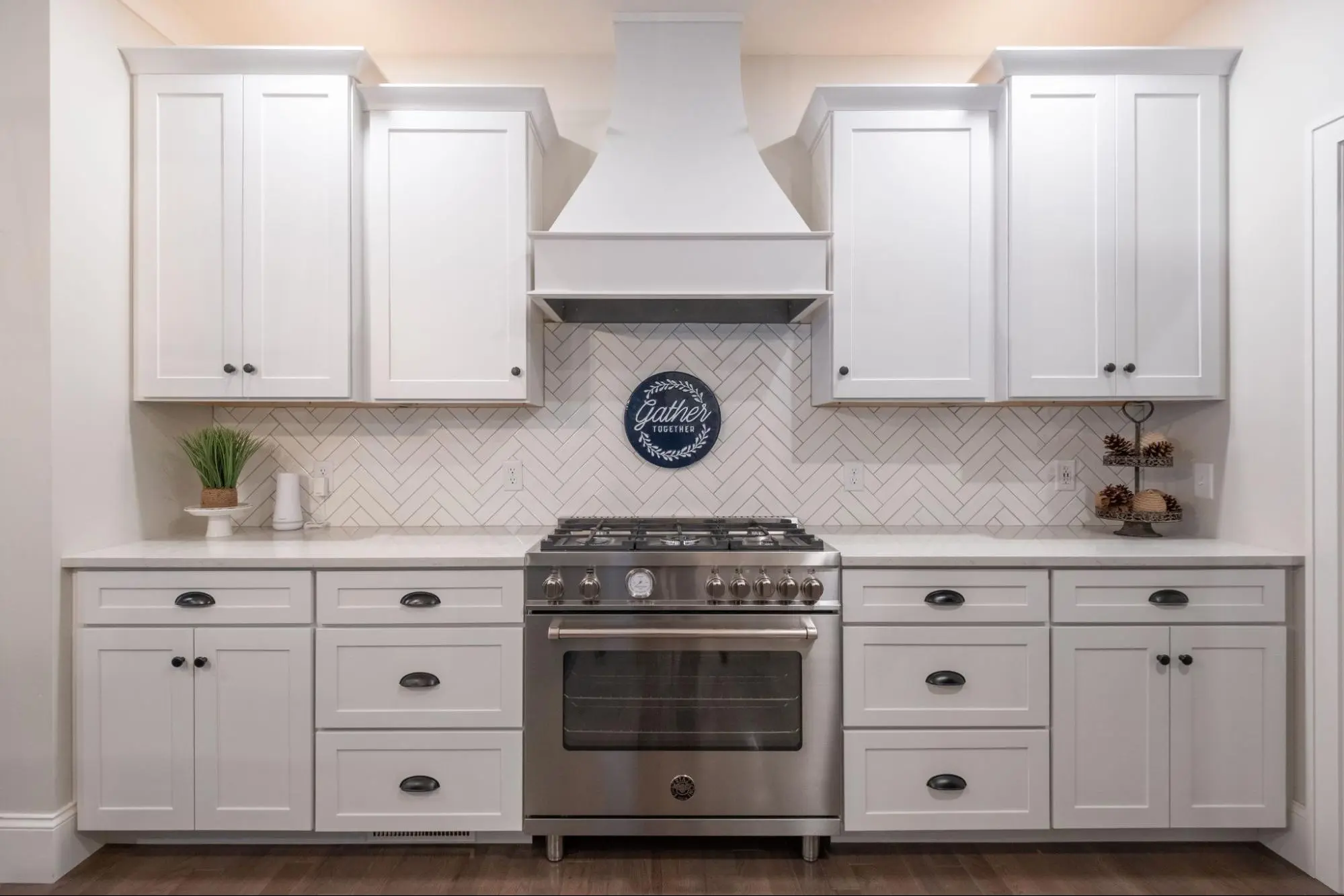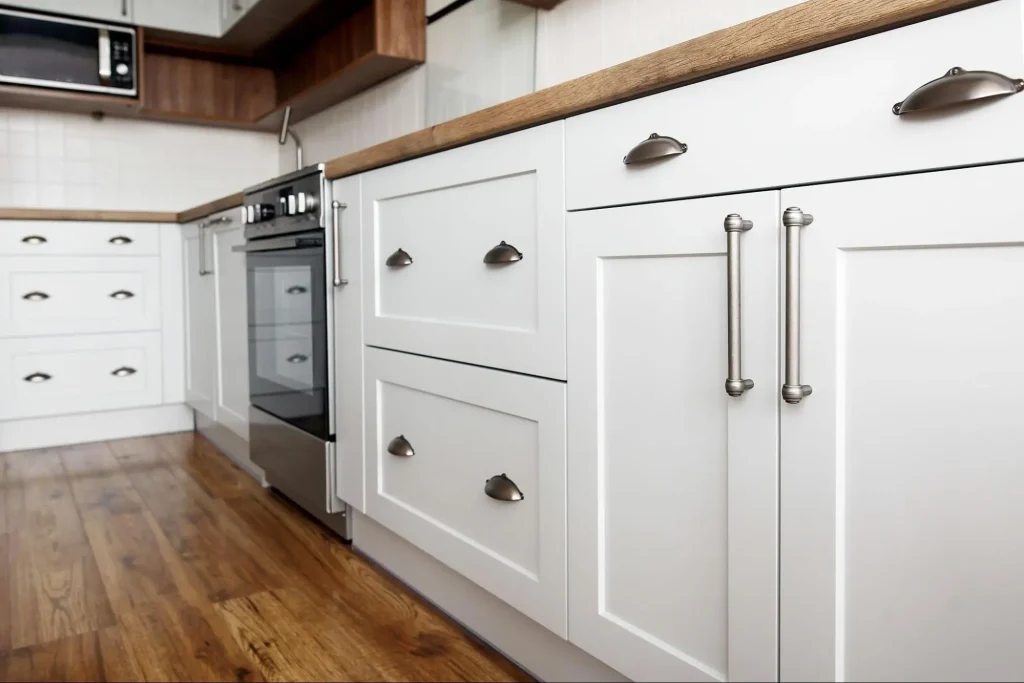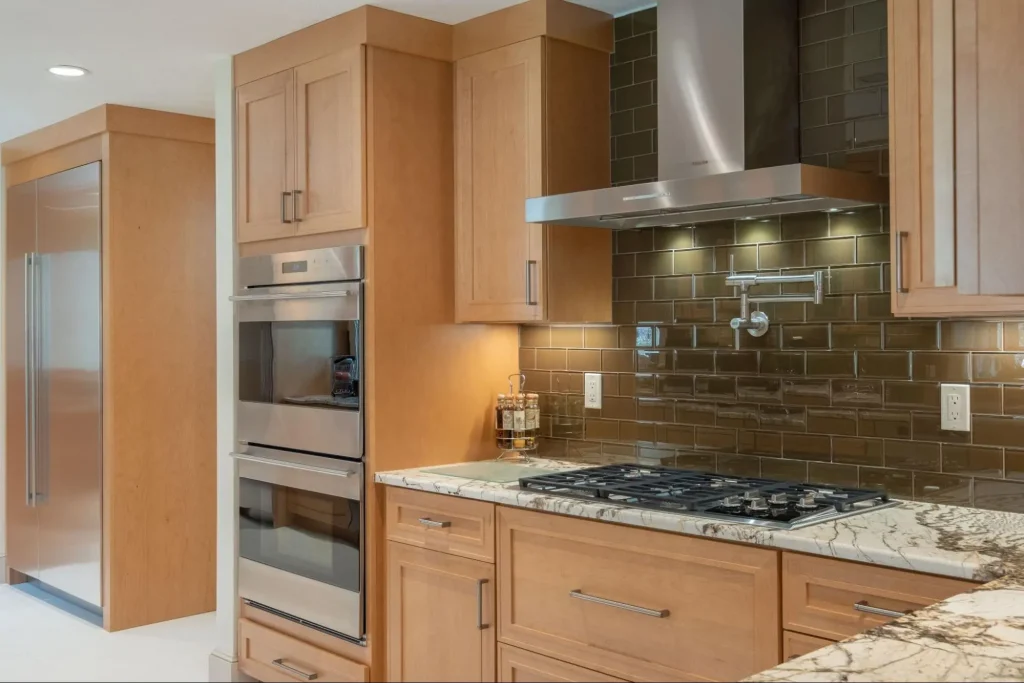
Selecting the right kitchen cabinets is crucial to the functionality and ambiance of your kitchen space. Your choice determines not only the practicality of your kitchen but also sets the aesthetic tone. The cabinets are the workhorse of the kitchen, influencing everything from storage to the layout of your cooking space. By considering key factors such as material quality, design preferences, and your kitchen’s configuration, you can find cabinets that are both beautiful and serviceable.
Navigating the myriad of options available for kitchen remodeling can be overwhelming, from deciding on the types of cabinets that suit your style to choosing materials that promise longevity and ease of maintenance. Having a clear understanding of your budget is also essential, as it affects the range and quality of cabinets you can consider. Thoughtful consideration of every aspect, from the features and accessories that enhance organization to the aesthetic details and finishes, will ensure that your kitchen cabinets are as functional as they are visually appealing.
Before choosing kitchen cabinets, it’s crucial to understand your kitchen’s layout. Knowing the exact dimensions of your space and the placement of appliances and features will help you maximize storage and functionality.
First, accurately measure the floor space of your kitchen. Record the length and width; then calculate the square footage. It’s essential to capture the ceiling height as well, since this can influence the height of your cabinets. Note any structural elements, like load-bearing walls, that could impact your design.
Your kitchen’s design must accommodate existing appliances and windows. Ensure that there is ample clearance for the swing of appliance doors and that windows are not obstructed. Consider the work triangle between the stove, refrigerator, and sink, which should be efficient and unblocked.
For storage optimization, look at your kitchen’s size realistically. If you have a small kitchen, think vertically, using taller cabinets to utilize all available space. Remember, the right layout will keep everything accessible, whether you’re reaching for a spice or stowing away a mixer.

When selecting kitchen cabinets, your personal style and design preferences set the foundational tone. It’s vital to choose materials, colors, and styles that reflect your taste and integrate seamlessly with your home’s aesthetic.
The material of your kitchen cabinets not only dictates durability but also sets the stage for your kitchen’s overall feel. Hardwood is renowned for its longevity and classic appeal, while plywood offers a cost-effective yet sturdy alternative. If you prefer a modern look, consider laminate or thermofoil for a sleek finish that’s easy to maintain. Weigh each material’s traits against your lifestyle and kitchen design to ensure a harmonious balance.
Your kitchen cabinet’s color should complement both the counter and the overall kitchen palette. If you opt for a monochromatic scheme, use shades or tints of the same color for a refined and understated look. For a bolder impression, contrasting colors can create a dynamic and visually striking space. Always test samples under your kitchen’s lighting to gauge how the cabinets’ color will appear during different times of the day.
Cabinet door style is a defining element of your kitchen’s character. Flat-panel cabinets embody a minimalistic approach suitable for contemporary spaces, offering clean lines and an uncluttered aesthetic. On the flip side, raised-panel cabinets bring forth a traditional and detailed look, perfect for achieving a classic and timeless ambiance. When considering cabinet styles, aim for a cohesive look that aligns with both your lifestyle and the architectural details of your home. For example, modern kitchens may benefit from clean, simple, and contemporary pulls to enhance the cabinet design, whereas classic fixtures work well with more ornate cabinet styles.
Selecting the right type of kitchen cabinet is essential to both the function and style of your kitchen. You’ll encounter a variety of options, from cost-effective stock cabinets to fully customizable solutions, along with different constructions that can alter the cabinet’s appearance and use.
Stock Cabinets are your most accessible and budget-friendly choice. These are pre-manufactured in standard sizes, typically increasing in 3-inch increments. Because of their mass production, stock cabinets offer limited styles and finishes but are readily available and can be a functional choice for your kitchen if you’re looking for a straightforward, no-frills option.
On the other end of the spectrum, Custom Cabinets are designed to your specifications, offering a perfect fit and tailored to your exact wishes in material, style, and size. As expected, this level of customization means a higher cost and a longer lead time, but results in a unique and versatile kitchen space.
Semi-custom cabinets strike a balance between the two; they offer a wider variety of sizes and finishes than stock cabinets, giving you a more personalized look without the full cost or wait time of fully custom cabinetry.
Frame Cabinets are characterized by a face frame that outlines the cabinet box. Doors and drawers attach to this frame, which adds dimension and traditional style to your cabinets. It’s worth noting that frame cabinets are often more sturdy due to the additional framing.
In contrast, Frameless Cabinets provide a modern, clean look, with doors and drawers attaching directly to the cabinet box, giving a seamless appearance. They are also known as “full overlay” because the doors cover the entire cabinet box, maximizing interior storage space and offering a sleek, contemporary aesthetic.
For a kitchen tailored to your lifestyle, consider Specialty Units. These types of cabinets are designed for specific functions, elevating your kitchen beyond the basics. Examples include corner cabinets with a Lazy Susan for easy access, pull-out trash bins, or appliance garages to keep your counters clear and organized. Specialty units can enhance the functional and versatile nature of your kitchen, making it truly customized to your needs.
When selecting kitchen cabinets, it’s essential to consider how features and accessories can enhance organization. Ensure every item has its place with smart organizational solutions.
Drawers can transform your kitchen experience with functionality that caters to a variety of storage needs. Choose deep drawers for pots and pans to keep them easily accessible, while slim drawers are perfect for cutlery and utensils. Adjustable shelving empowers you to customize the space for plates and cookware, making the most of every inch. Consider inserts like utensil organizers to keep drawers tidy.
Enhance accessibility with pull-out drawers and racks. These features allow you to view and retrieve items without the hassle of digging through your cabinets, creating an efficient kitchen workflow. Pull-out organizers in cabinet bases make for convenient access for storing pans and lids. Slide-out spice racks and pull-out baskets offer organized spaces for smaller items, ensuring that everything has a designated spot.
Maximize corner storage with innovative solutions like the lazy Susan and corner cabinets designed with intricate pull-out mechanisms. These features offer unparalleled organization, dramatically increasing the usability of hard-to-reach areas. With rotating shelves or pull-out accessories, your corner cabinet becomes highly functional, offering easy access to all your cookware.
By incorporating these organizational features and accessories, your kitchen cabinets become more than just storage spaces—they evolve into an efficient, user-friendly part of your daily kitchen use.
When choosing the right kitchen cabinets, the quality and durability of materials are vital to ensure longevity and performance. This section will guide you through selecting the most suitable materials for your cabinets that stand the test of time.
Wood: Solid wood is renowned for its natural strength and timeless appeal, with options like oak offering remarkable durability. Each wood type has a unique color, grain, and texture, making your cabinets distinct.
Plywood: An engineered wood, plywood adds structural strength to cabinets. Look for high-grade plywood as it offers fewer defects and better resistance to warping, especially in humid environments.
Alternatives:
Drawer Fronts: Your drawer fronts can be made from solid wood, plywood, or MDF, each offering different levels of durability and aesthetics. Solid wood leads to durability but may cost more.
Door Materials: The doors of your cabinets get a lot of use, so the material choice here is critical. Whether you choose solid wood or a combination of wood and glass, make sure it complements the style and function of your kitchen.
Hardware: The quality of knobs and drawer pulls directly affects the longevity and use of your cabinets. Opt for hardware made from solid metals as they withstand frequent use better than plastic alternatives.
Joinery: The construction method used to assemble your kitchen cabinets plays a critical role in their durability. Dovetail joinery is known for strength, while dowel or mortise-and-tenon provides sturdy corners.
Remember, high-quality materials and solid construction will ensure that your kitchen cabinets will maintain their functionality and appearance over time. Choose wisely and balance your budget with the benefits of durability for the best outcomes.
The smallest details often make the biggest impact when personalizing your kitchen cabinets. Selecting the right hardware, finishes, and decorative elements is essential to achieving a cohesive look that reflects your style.
Your choice of hardware can drastically change the look of your kitchen cabinets. For a modern design, consider slim, sleek pulls or even a touch-latch system for a handle-free look. Shaker-style cabinets often benefit from classic knobs and cup pulls in a brushed or satin finish. Always select hardware that complements both the style of your cabinets and the overall design of your kitchen.
Deciding whether to go for painted or stained cabinet finishes depends on the aesthetic you’re aiming for. Painted finishes allow for more color options, giving you the freedom to match or contrast with your kitchen’s color scheme. Meanwhile, stained finishes showcase the wood’s natural grain and bring warmth to your space. Both finishes require different maintenance and offer varying levels of durability.
Molding and decorative elements can elevate the look of your kitchen. Crown molding installed at the top of your cabinets extends the line of your cabinetry to the ceiling, creating a more refined and finished look. Decorative elements like corbels, onlays, and inset cabinet doors can add a layer of sophistication. These details should be chosen carefully to maintain a cohesive design throughout your space.
When opting for new kitchen cabinets, you need to carefully assess your finances and the implications of your choices. It’s essential to determine a budget that reflects the value you expect from the investment, without compromising on quality.
To start, assess your overall renovation budget. Kitchen cabinets typically consume a significant portion of this budget, so setting a clear figure can guide your decisions. For a standard 10-ft. x 10-ft. kitchen, costs can range from a few thousand dollars for stock cabinets to much higher for custom work. Keep in mind the long-term value of your investment; choosing merely based on the cheapest option might lead to additional costs down the line due to lower quality or durability.
Finding a middle ground between cost and quality means understanding the materials and construction of the cabinets. Semi-custom cabinets offer a compromise, allowing for some level of customization and better quality without the expense of fully custom units. Retailers offer various grades, and it’s crucial to weigh the features versus the cost. Consider factors like the type of wood, the thickness of the shelving, and the hardware quality.
Your priority should be aligning your budget with anticipated quality and the long-term value that your new kitchen cabinets will add to your home.

Selecting the perfect kitchen cabinets is only part of the journey; installing them correctly and maintaining their appearance and functionality are crucial for their longevity. Whether you opt for professional installation or tackle it DIY-style, understanding the necessary care, cleaning, and potential upgrades will help preserve your investment.
Should you hire a professional or install your cabinets yourself? This decision hinges on your skill level, budget, and the complexity of your project. Professional installers ensure precision and often provide warranties for their work. For intricate designs or layouts involving hardwood cabinets or adjustable shelves, their expertise can be invaluable. On the flip side, if you’re a confident DIYer, some resources can guide you through the process, potentially saving you money.
Maintaining the look and function of your cabinets involves routine care. Wiping spills immediately and avoiding harsh chemicals will prevent damage. For daily cleaning, use a soft cloth with warm water and mild detergent. Specific maintenance depends on the material, but generally, applying a wood cleaner periodically can maintain the luster of hardwood cabinets. Be mindful that adjustable shelves require occasional tightening to ensure stability.
As time goes on, you might want to refresh or upgrade your cabinets without a full remodel. Cabinet refacing is a cost-effective way to update your kitchen’s look. This involves replacing drawer fronts and cabinet doors while keeping the existing structure intact. For an upgrade, consider adding pull-out shelves or soft-close hinges. Such updates can enhance functionality and add a modern touch to your space.
When you’re investing in kitchen cabinets, the quality of the retailer or vendor can be just as crucial as the cabinets themselves. This section will guide you through a streamlined process to identify the best retailers and brands, review their product offerings, and compare the customer service and warranties they offer.
Begin by identifying brands with a reputation for quality and reliability. Look for those who provide detailed product specifications and transparent pricing. For example, kitchen cabinets made of cabinet-grade plywood are known for their durability compared to less sturdy materials like particleboard. Perform due diligence by reading online reviews and checking rankings to get a sense of which brands are respected in the industry.
Next, explore a mix of both physical showrooms and online stores. Showrooms allow you to get a tactile sense of the cabinets, and you can visually inspect the craftsmanship. When visiting a showroom, notice if they exhibit a wide range of options and styles that reflect current trends and classic designs. Online stores offer a breadth of options and can be quite informative.
Finally, prioritize retailers who offer excellent customer service and product warranties. Customer service should be accessible, knowledgeable, and ready to assist you with after-sales support. A substantial warranty indicates a brand’s confidence in its product quality—it’s advisable to seek warranties that cover the product for an extended period. Sources such as Consumer Reports emphasize the importance of looking for solid warranties and robust customer support networks.
Choosing the right kitchen cabinets is a critical decision that affects the functionality and aesthetic appeal of your home. By understanding the different types of cabinets, materials, and styles available, and considering your storage needs and budget, you can select the perfect cabinets for your kitchen. Kaminskiy Care and Repair stands as a leading provider, offering quality, reliability, and style when installing kitchen cabinets. With our expertise, you can achieve the kitchen of your dreams that is as functional as it is beautiful. Remember, the right kitchen cabinets not only improve your home’s value but also enhance your everyday living experience. Contact us today!
When choosing kitchen cabinetry, consider factors such as quality, material, size, layout, and design to ensure a perfect fit for your home.
Your kitchen’s functionality and aesthetic are directly tied to the cabinets you choose. It’s important to consider the cabinet’s construction, door styles, color, finish, and hardware, as well as the kitchen’s current layout and storage needs.
High-quality kitchen cabinets exhibit sturdy construction, smooth drawer operation, and robust door hinges. They are typically made of cabinet-grade plywood and have well-finished surfaces that withstand daily use.
Durable and stylish kitchen cabinets are often made from solid wood, but plywood and medium-density fiberboard (MDF) are also great options. They offer a balance of durability and design flexibility to match any kitchen style.
Measure your kitchen’s dimensions carefully and consider the placement of appliances and features. Utilize every inch of space efficiently with options such as lazy Susans or pull-out drawers for optimal organization and accessibility.
Wooden cabinets offer timeless appeal and strength but can be subject to warping in humid climates. Alternative materials like thermofoil or laminate are more budget-friendly and resist moisture better but may not have the same longevity or luxurious feel.
Consider your kitchen’s color scheme and overall style. For a cohesive look, match your cabinets with the style, whether it’s modern, traditional, or transitional. Cabinet finish and hardware also play a crucial role in complementing your kitchen’s design.